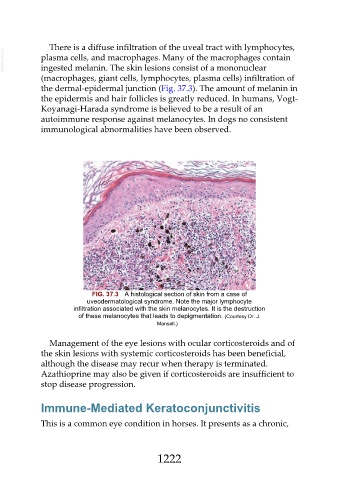Page 1222 - Veterinary Immunology, 10th Edition
P. 1222
There is a diffuse infiltration of the uveal tract with lymphocytes,
VetBooks.ir plasma cells, and macrophages. Many of the macrophages contain
ingested melanin. The skin lesions consist of a mononuclear
(macrophages, giant cells, lymphocytes, plasma cells) infiltration of
the dermal-epidermal junction (Fig. 37.3). The amount of melanin in
the epidermis and hair follicles is greatly reduced. In humans, Vogt-
Koyanagi-Harada syndrome is believed to be a result of an
autoimmune response against melanocytes. In dogs no consistent
immunological abnormalities have been observed.
FIG. 37.3 A histological section of skin from a case of
uveodermatological syndrome. Note the major lymphocyte
infiltration associated with the skin melanocytes. It is the destruction
of these melanocytes that leads to depigmentation. (Courtesy Dr. J.
Mansell.)
Management of the eye lesions with ocular corticosteroids and of
the skin lesions with systemic corticosteroids has been beneficial,
although the disease may recur when therapy is terminated.
Azathioprine may also be given if corticosteroids are insufficient to
stop disease progression.
Immune-Mediated Keratoconjunctivitis
This is a common eye condition in horses. It presents as a chronic,
1222

